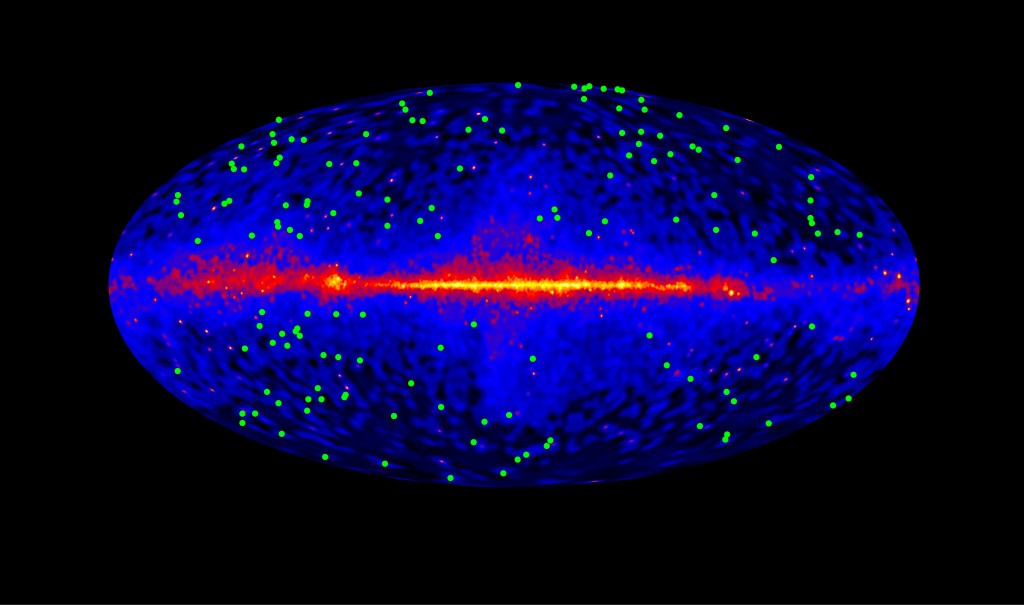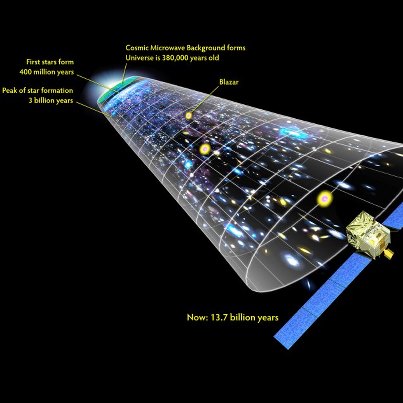Astronomers using data from NASA’s Fermi Gamma-ray Space Telescope have made the most accurate measurement of starlight in the universe and used it to establish the total amount of light from all of the stars that have ever shone, accomplishing a primary mission goal.
“The optical and ultraviolet light from stars continues to travel throughout the universe even after the stars cease to shine, and this creates a fossil radiation field we can explore using gamma rays from distant sources,” said lead scientist Marco Ajello, a postdoctoral researcher at the Kavli Institute for Particle Astrophysics and Cosmology at Stanford University in California and the Space Sciences Laboratory at the University of California at Berkeley.
This animation tracks several gamma rays through space and time, from their emission in the jet of a distant blazar to their arrival in Fermi’s Large Area Telescope (LAT). During their journey, the number of randomly moving ultraviolet and optical photons (blue) increases as more and more stars are born in the universe. Eventually, one of the gamma rays encounters a photon of starlight and the gamma ray transforms into an electron and a positron. The remaining gamma-ray photons arrive at Fermi, interact with tungsten plates in the LAT, and produce the electrons and positrons whose paths through the detector allows astronomers to backtrack the gamma rays to their source. (Credit: NASA’s Goddard Space Flight Center/Cruz deWilde)
Gamma rays are the most energetic form of light. Since Fermi’s launch in 2008, its Large Area Telescope (LAT) observes the entire sky in high-energy gamma rays every three hours, creating the most detailed map of the universe ever known at these energies.
The total sum of starlight in the cosmos is known to astronomers as the extragalactic background light (EBL). To gamma rays, the EBL functions as a kind of cosmic fog. Ajello and his team investigated the EBL by studying gamma rays from 150 blazars, or galaxies powered by black holes, that were strongly detected at energies greater than 3 billion electron volts (GeV), or more than a billion times the energy of visible light.
“With more than a thousand detected so far, blazars are the most common sources detected by Fermi, but gamma rays at these energies are few and far between, which is why it took four years of data to make this analysis,” said team member Justin Finke, an astrophysicist at the Naval Research Laboratory in Washington.

This plot shows the locations of 150 blazars (green dots) used in the EBL study. The background map shows the entire sky and was constructed from four years of gamma rays with energies above 10 billion electron volts (GeV) detected by Fermi. The plane of our Milky Way galaxy runs along the middle of the plot. The Fermi LAT instrument is the first to detect more than 500 sources in this energy range. (Credit: NASA/DOE/Fermi LAT Collaboration)
As matter falls toward a galaxy’s supermassive black hole, some of it is accelerated outward at almost the speed of light in jets pointed in opposite directions. When one of the jets happens to be aimed in the direction of Earth, the galaxy appears especially bright and is classified as a blazar.
Gamma rays produced in blazar jets travel across billions of light-years to Earth. During their journey, the gamma rays pass through an increasing fog of visible and ultraviolet light emitted by stars that formed throughout the history of the universe.
Occasionally, a gamma ray collides with starlight and transforms into a pair of particles–an electron and its antimatter counterpart, a positron. Once this occurs, the gamma ray light is lost. In effect, the process dampens the gamma ray signal in much the same way as fog dims a distant lighthouse.
From studies of nearby blazars, scientists have determined how many gamma rays should be emitted at different energies. More distant blazars show fewer gamma rays at higher energies–especially above 25 GeV–thanks to absorption by the cosmic fog.
The farthest blazars are missing most of their higher-energy gamma rays.

Fermi measured the amount of gamma-ray absorption in blazar spectra produced by ultraviolet and visible starlight at three different epochs in the history of the universe. (Credit: NASA’s Goddard Space Flight Center)
The researchers then determined the average gamma-ray attenuation across three distance ranges between 9.6 billion years ago and today.
From this measurement, the scientists were able to estimate the fog’s thickness. To account for the observations, the average stellar density in the cosmos is about 1.4 stars per 100 billion cubic light-years, which means the average distance between stars in the universe is about 4,150 light-years.
A paper describing the findings was published in late October on Science Express.
“The Fermi result opens up the exciting possibility of constraining the earliest period of cosmic star formation, thus setting the stage for NASA’s James Webb Space Telescope,” said Volker Bromm, an astronomer at the University of Texas, Austin, who commented on the findings. “In simple terms, Fermi is providing us with a shadow image of the first stars, whereas Webb will directly detect them.”

This illustration places the Fermi measurements in perspective with other well-known features of cosmic history. Star formation reached a peak when the universe was about 3 billion years old and has been declining ever since. (Credit: NASA’s Goddard Space Flight Center)
Measuring the extragalactic background light was one of the primary mission goals for Fermi.
“We’re very excited about the prospect of extending this measurement even farther,” said Julie McEnery, the mission’s project scientist at NASA’s Goddard Space Flight Center in Greenbelt, Md.
Goddard manages the Fermi astrophysics and particle physics research partnership. Fermi was developed in collaboration with the U.S. Department of Energy with contributions from academic institutions and partners in France, Germany, Italy, Japan, Sweden and the United States.
Francis Reddy, NASA’s Goddard Space Flight Center, Greenbelt, Md.
Courtesy NASA.gov, 11-01-12
Felix Baumgartner Survived Because of One of These: It’s All About the Suit, Baby!

Felix Baumgartner in supersonic free-fall, 14 October 2012
DRESSING FOR ALTITUDE
U.S. Aviation Pressure Suits–Wiley Post to Space Shuttle
A free e-book by Dennis R. Jenkins
Austrian skydiver Felix Baumgartner was rightly hailed when on 14 October he became the first person to break the sound barrier without vehicular power on his descent. As part of this project, he set the altitude record for a manned balloon flight, parachute jump from the highest altitude, and greatest free fall velocity.
But the fact is, no high-tech aviation pressure suit, no feats of aeronautical derring-do for Felix Baumgartner. In his new e-book, Dressing for Altitude, author Dennis R. Jenkins traces the little-known history of these amazing outfits, which have been essential but mostly overlooked elements of space exploration.

Anybody who has watched many movies or television shows has seen them—the ubiquitous silver suits worn by pilots as they explore the unknown. They are called pressure suits, and one can trace their lineage to Wiley Post or, perhaps, a bit earlier.
There are two kinds of pressure suits: partial pressure and full pressure. David Clark, the man, once pointed out that these were not very good names, but they are the ones that stuck. In a partial-pressure suit, the counter-pressure is not as complete as in a full-pressure suit, but it is placed so that shifts in body fluids are kept within reasonable limits. On the other hand, a full-pressure suit, which is an anthropomorphic pressure vessel, creates an artificial environment for the pilot.
One type of pressure suit is not necessarily “better” than the other, and both partial pressure and full pressure suits are still in limited use around the world. Both type of suits have benefits and limitations and, by and large, pilots dislike both, even while acknowledging their necessity. For the past 60 years, they have been an indispensible part of a small fragment of the aviation world.
Although space suits, which differ from pressure suits in subtle, but important ways, have been well covered in literature, pressure suits have gone unheralded except as introductions to the space suit histories. This e-book is an attempt to correct that, and covers pressure suits from the beginning through the end of the Space Shuttle Program.
Courtesy NASA.gov
Download Dressing for Altitude as a free pdf.


